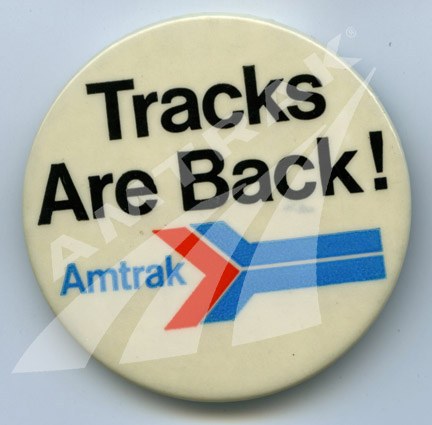Digging into the Archives: Tracks are Back!
CommentsJanuary 30, 2013
Over the last few months, I’ve been scanning a collection of Amtrak buttons and pins that span the company’s more than four decades as America’s intercity passenger rail provider. Primarily developed by the Marketing department, they were meant to highlight new services, company-wide safety programs, sales promotions and other initiatives.
While there are dozens of buttons, our nascent archival collection lacks photos of employees or passengers wearing them, so it’s not always clear for whom the buttons were intended. Were they to be worn by station staff and onboard crew members to advertise promotions? Were they given out to passengers as souvenirs? Were they sold aboard the trains?
That’s why it was so rewarding to discover a set of photographs by Charles O’Rear taken aboard Amtrak trains during the summer of 1974. At that point, the National Railroad Passenger Corporation, commonly known as Amtrak, had only operated the nation’s intercity passenger rail system for three years. Trains were a mix-match of different equipment obtained from railroads that had turned over passenger operations to Amtrak under the provisions of the Rail Passenger Service Act of 1970.
Some employees worked directly for the company, while others, including most engineers and conductors, were contractors who remained on the payroll of the private railroads over whose tracks Amtrak ran its trains.
Recently posted on the Atlantic Cities website, the images were produced by O’Rear for DOCUMERICA, a program sponsored by the Environmental Protection Agency to photographically record subjects of environmental concern in America during the 1970s. Topics were quite diverse, spanning junk yards to mining scenes to transportation systems. The resulting photographs provide an interesting glimpse into the early days of Amtrak, documenting meal services, crew uniforms and station interiors. Asked by Eric Jaffe of Atlantic Cities on why he had chosen the passenger railroad as his muse, O’Rear responded: “There had been virtually no photography made of Amtrak for national distribution…So I proposed riding Amtrak for a month, I think it was. ‘Let’s see what Amtrak’s all about.’”
Going through the images, I was excited to find a handful that featured people wearing a button emblazoned with the company’s name, first service mark and the phrase “Tracks are Back!”. I had just scanned this same button for our digital archives and had assumed that it was probably from the early 1970s. In those first years, the company enthusiastically informed the traveling public about its services and highlighted upgrades it had made to the passenger rail system, such as refurbished rail cars, renovated stations and a simplified national reservation system.
With these photos, I knew that the buttons were in use by 1974 and available to onboard crew members and passengers—and even dolls! The “Tracks are Back!” slogan certainly rang true in 1974, as ridership hit a new high of 18.5 million passengers. Many were new riders who decided to try the train due to the 1973-1974 OPEC Oil Embargo and the resulting gasoline shortages.

Button in the Amtrak Archives
The name “Amtrak” was developed by Lippincott & Margulies, a design firm specializing in corporate identities. It is the blending of the words "American" and "track." To complement the name, a motion-oriented service mark, known as the “motion mark,” was designed with modern graphics featuring the patriotic colors of red, white and blue. Although it’s a little off-kilter on the button in our collection, the service mark remains bright. It was employed from 1971 until 2000 when the current blue travel mark, composed of abstract lines curving to the horizon, came into use.
Check out other interesting buttons from our collection and explore the Amtrak photos in the DOCUMERICA collection.
-------------------------------------------------------------------------------------------------------------
Photos courtesy of the National Archives, Record Group 412 (DOCUMERICA: The Environmental Protection Agency's Program to Photographically Document Subjects of Environmental Concern, 1972 - 1977).




